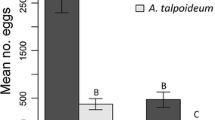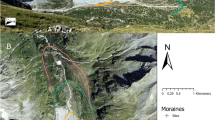Abstract
Cochlearia bavarica Vogt andC. pyrenaica Dc. are closely related and highly endangered species in Bavaria (SE Germany).Cochlearia bavarica (2n=36) is a hybrid ofC. pyrenaica (2n=12) andC. officianalis (2n=24) stabilized by polyploidy.Cochlearia officinalis does not occur in Bavaria. The question being addressed is whether the present non-overlapping distribution of the two Bavarian species, both of which are restricted to calcareous springs with a continuous water supply or drainage ditches, is due to competitive exclusion or to subtle differences of ecological requirements. I did not find any evidence for the second case, i.e. niche differentiation, because both species occurred in all the habitat types that I could define by floristic and ecological criteria. The population structures of bothC. bavarica andC. pyrenaica vary in parallel with different habitat types. Both species have the greatest reproductive output (viable seeds) and the highest population densities in habitats with high light availability and/or low interspecific competition. Thus, I expected that one of the two species might be competitively superior over the other, but that it would fail to reach all its potential sites of occurrence.
Cochlearia bavarica individuals (dry mass =5.75 g) grow significantly larger thanC. pyrenaica individuals (3.62 g;P<0.05) and produce more, larger and heavier seeds, possibly due to hybrid vigour. Flowering individuals ofC. bavarica also allocate more biomass to vegetative structures thanC. pyrenaica. The analysis of population dynamics reveals a higher life expectancy and reproductive output inC. bavarica. The calculated population growth rates although negative over the observation period in both species, suggest a significantly higher fitness ofC. bavarica (λ=0.66) compared withC. pyrenaica (λ=0.44). Thus, our data are in line with the competitive exclusion hypothesis andCochlearia bavarica appears as an example of a species with hybridogenous origin possessing higher fitness than its progenitor. However, considering the rarity of both species it seems at present unlikely that the former will displace the latter over a large distributional region.
Similar content being viewed by others
References
Abs C. (1998):Vergleichende Populationsökologie von Cochlearia bavaricaund Cochlearia pyrenaica. DFG-Bericht, Freising.
Caswell H. (1989):Matrix population models: Construction, analysis, and interpretation. Sinauer Associates, Sunderland.
Ferson S. (1990):RAMAS/stage user manual: General Stage-based modeling for population dynamics. Applied Biomathematics, New York.
Frielingsdorf D. (1997):Einnischung zweier nah verwandter Arten Cochlearia bavarica (Vogt)und Cochlearia pyrenaica (DC.). Diploma Thesis, Lehrbereich Geobotanik der Forstw. Fak., Freising.
Given D.R. (1994):Principles and practice of plant conservation. Timber Press, Portland.
Gleeson S.K. &Tilman D. (1990): Allocation and the transient dynamics of succession on poor soils.Ecology 71: 1144–1155.
Gray A.J., Crawley M.J. &Edwards P.J. (eds.) (1987):Colonisation, succession and stability. Blackwell Scientific Publications, Oxford.
Hegi G. (1986):Illustrierte Flora von Mittel-Europa 4/1. Ed. 3. Verlag Paul Parey, Berlin.
Hickman J.C. &Pitelka L.F. (1975): Dry weight indicates energy allocation in ecological strategy analysis of plants.Oecologia 21: 117–121.
Koch M. (1995):Biogeographie und Artbildung in Polyploidkomplexen. Molekularsystematische Untersuchungen an MicrothlapsiF. K. Meyer und CochleariaL. (Brassicaceae). PhD Thesis. Department of Botany, University of Osnabrück, Osnabrück.
Koch M. (1996): Zur Ausbreitung des Dänischen Löffelkrautes (Cochlearia danica L.) als Küstensippe in das Niedersächsische Binnenland.Florist. Rundbr. 30: 20–23.
Koch M., Mummenhoff K. &Hurka H. (1996): Chloroplast-DNA restriction site variation and RAPD-analyses inCochlearia (Brassicaceae). Biosystematics and speciation.Nordic J. Bot. 16: 585–603.
Koch M., Hurka H. &Huthmann M. (1998): Isozymes, speciation and evolution in the polyploid complexCochlearia L. (Brasicaceae).Bot. Acta 111: 411–425.
Olff H., Pegtel D.M., van Groenendael J.M. &Bakker J.P. (1994): Germination strategies during grassland succession.J. Ecol. 82: 69–77.
Paschke M. (1997):Der Einfluß der Populationsgröße auf die Reproduktion und die genetische Vielfalt von Cochlearia bavaricaVogt. Diploma Thesis, Lehrbereich Geobotanik der Forstw. Fak., Freising.
Pickett S.T.A., Collons S.L. &Armesto J.J. (1987): A hierarchical consideration of causes and mechanisms of succession.Vegetatio 69: 109–114.
Rabinowitz D. (1978): Abundance and diaspore weight in rare and common prairie grasses.Oecologia 37: 213–219.
Silvertown J., Franco M., Pisanty I. &Mendoza A. (1993): Comparative plant demography — relative importance of life-cycle components to the finite rate of increase in woody and herbaceous perennials.J. Ecol. 81: 465–476.
SPSS Inc. (1993):SPSS base system syntax reference guide. Release 6.0. SPSS Inc., Chicago.
Vogt R. (1985): DieCochlearia pyrenaica-Gruppe in Zentraleuropa.Ber. Bayer. Bot. Ges. 56: 5–52.
Vogt R. &Heubl G.R. (1985): Chemosystematische Studien in der GattungCochlearia L (Cruciferae).Bot. Jahrb. Syst. 107: 177–194.
Vogt R. &Lippert W. (1988): Zur Verbreitung der GattungCochlearia L. in Bayern.Ber. Bayer. Bot. Ges. 59: 133–135.
Wyse Jackson P.S. &Akeroyd J.R. (1993): 62.Cochlearia L. In:Tutin T.G. et al. (eds.),Flora europaea 1, Ed. 2, Cambridge University Press, Cambridge, pp. 378–380.
Author information
Authors and Affiliations
Corresponding author
Rights and permissions
About this article
Cite this article
Abs, C. Differences in the life histories of twoCochlearia species. Folia Geobot 34, 33–45 (1999). https://doi.org/10.1007/BF02803075
Issue Date:
DOI: https://doi.org/10.1007/BF02803075




